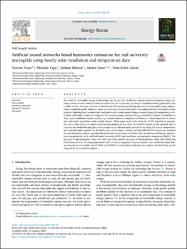| dc.contributor.author | Yarar, Nurcan | |
| dc.contributor.author | Yagci, Mustafa | |
| dc.contributor.author | Bahceci, Serkan | |
| dc.contributor.author | Onen, Ahmet | |
| dc.contributor.author | Ustun, Taha Selim | |
| dc.date.accessioned | 2024-02-26T12:24:33Z | |
| dc.date.available | 2024-02-26T12:24:33Z | |
| dc.date.issued | 2023 | en_US |
| dc.identifier.issn | 2772-4271 | |
| dc.identifier.other | WOS:001135942500001 | |
| dc.identifier.uri | https://doi.org/10.1016/j.nexus.2023.100172 | |
| dc.identifier.uri | https://hdl.handle.net/20.500.12573/1967 | |
| dc.description.abstract | The need for renewable energy is increasing day by day due to different factors such as increasing energy demand, environmental considerations as well as the will to decrease the share of fossil fuel-based generation. Due
to their relative low-cost and ease of installation, PV systems are leading the way for renewable energy deployments around the globe. However, there are meticulous studies that need to be undertaken for realization of such
projects. Studying local weather and load patterns for proper panel sizing or considering grid components to determine cable and transformer sizing can be named as some examples for pre-installation studies. In addition to
these, post-installation impact studies, e.g. accurate harmonic analysis contribution, is more important to ensure
safe and secure operation of the overall system. These steps need to be taken for all PV installation projects.
The aim of this study is to show a step-by-step analysis of the effect of a real PV system on the network and to
improve the prediction and give a new perspective to the harmonic estimation by using the hourly temperature
and radiation data together. At the first phase of the study, a detail real-time 250 kW PV system was modeled
for real university campus, and then harmonic estimation based on hourly solar irradiation and hourly temperature was performed with artificial neural networks (ANN) and nonlinear autoregressive exogenous (NARX). The
accuracy of the prediction made with ANN was 0.98, and the accuracy of the prediction made with NARX was
0.96.Researchers in PV sizing and control field as well as engineers in power quality area would find these findings beneficial and useful. Use of ANNs and NARX for such analysis indicates the trend in this field that can be
targeted by new research projects. | en_US |
| dc.language.iso | eng | en_US |
| dc.publisher | ELSEVIER | en_US |
| dc.relation.isversionof | 10.1016/j.nexus.2023.100172 | en_US |
| dc.rights | info:eu-repo/semantics/openAccess | en_US |
| dc.subject | Power quality | en_US |
| dc.subject | Harmonic estimation | en_US |
| dc.subject | Campus PV Systems | en_US |
| dc.subject | Microgrid | en_US |
| dc.title | Artificial neural networks based harmonics estimation for real university microgrids using hourly solar irradiation and temperature data | en_US |
| dc.type | article | en_US |
| dc.contributor.department | AGÜ, Mühendislik Fakültesi, Elektrik - Elektronik Mühendisliği Bölümü | en_US |
| dc.contributor.authorID | 0000-0001-7086-5112 | en_US |
| dc.contributor.institutionauthor | Onen, Ahmet | |
| dc.identifier.volume | 9 | en_US |
| dc.identifier.startpage | 1 | en_US |
| dc.identifier.endpage | 9 | en_US |
| dc.relation.journal | ENERGY NEXUS | en_US |
| dc.relation.publicationcategory | Makale - Uluslararası Hakemli Dergi - Kurum Öğretim Elemanı | en_US |


















